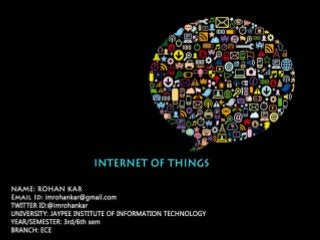
Internet of Things
- 2. What is IoT The IoT is a computational concept that brings a future where physical objects will be connected to the internet and be able to identify themselves to other devices. The IoT is a difficult concept to define precisely. The term is closely identified with RFID as the method of communication, although it may also include other sensor technologies, wireless technologies or QR codes. “The IoT is significant because any an object that has the ability to work digitally becomes much more than an object itself. It becomes an asset. The object not only relates to us but also to many other objects in unison”
- 3. Trends Current Scenario In Industries supply chains plays a major role. Many shipping companies are now using wireless connectivity to remotely monitor their mobile assets. This connectivity enables M2M-based Internet of Things functionality, such as the ability to report on the location and route of a truck or the humidity, temperature, and/or pressure of its cargo. The added intelligence provided by the Internet of Things plays a critical role in ensuring regulatory compliance and the safety of our global food and pharmaceutical supply chains. Many local governments and municipalities dream of being able to minimize traffic jams or manage water main breaks or snow removal issues from afar. A number of communities are already making the Internet of Things a reality in their towns by starting small. For instance, water quality and wastewater management are being improved with the use of thousands of tiny sensors that wirelessly report on everything from water levels to the type of bacteria in the water to blocked water mains. The real value of the Internet of Things comes in enabling doctors to remotely manage specific diseases or general patient wellness. Critical care monitoring will be driven by rugged, purpose-built devices with necessary privacy and security measures built in, and will be operated largely by healthcare providers and payers. Informational wellness monitoring, on the other hand, will almost certainly be dominated by the smartphone, especially for the curious consumer.
- 4. IoT in Next Five Years Overview of a smart city using IoT is going to make a big impact in next 5 years
- 5. SWOT ANALYSIS Strength Offers development in healthcare. Save time and money Billions of investment by governments Weakness Still a fairly new concept Privacy of the user is a matter of concern Security and maintenance of private data Opportunity Opportunity in increased efficiency in supply chain and logistics Development of smart buildings and smarter planet Integration with artificial intelligence and automation Threats Fear of technology overtaking employment Robots communicating with each other
- 6. Interest Areas The reason to choose the topic is because of my interest in Smart City development where I have worked earlier. Creating a sustainable city which is digitally equipped is something I intend to work on. Smart City is a very new concept where every Government in the world is working to improve the lives of the people. IoT gives an unique opportunity for cities to have smart transport system, smart roads, smart waste management, smart currency. Smart city through IoT is the next big thing. I would like to develop products that help people living in a city to easily transact, mobilize and socialize. If offered an internship I would like to work on predicting customer churn as it helps improve product design and develop better product strategies
